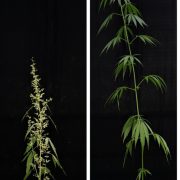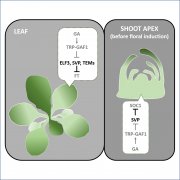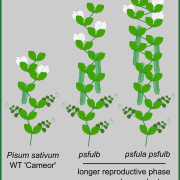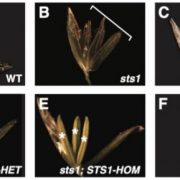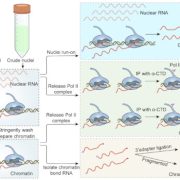The P-body component DECAPPING5 regulates flowering time via liquid-liquid phase separation
Wang et al. investigate role of the DCP5-SSF complex in the nucleus
https://doi.org/10.1093/plcell/koad151
Wanyi Wang, Chuanhong Wang, Yunhe Wang, Jing Ma. The National Engineering Lab of Crop Stress Resistance Breeding, the School of Life Sciences, Anhui Agricultural University.
Background: Typical organelles such as mitochondria and chloroplasts are surrounded by membranes. However, eukaryotic cells also contain organelles that lack membranes. For example, P-bodies consist of cytoplasmic condensates and act in mRNA processing, including mRNA decapping, mRNA degradation, deadenylation, RNA-mediated post-transcriptional gene silencing, and nonsense-mediated decay P-bodies are conserved across eukaryotes. In plants, P-bodies and their constituent proteins undergo liquid-liquid phase separation (LLPS). In LLPS, proteins and nucleic acids form a dense, separate phase that looks like droplets of liquid. However, it is unclear where the LLPS occurs and how it is related to important biological processes such as flowering time, which affects plant growth, development, and seed yield.
Question: What is the function of the essential P-body component DECAPPING5 (DCP5)? How does DCP5 affect flowering time?
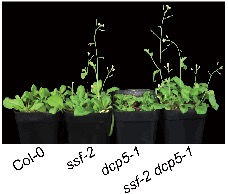 Findings: We applied protein co-immunoprecipitation combined with mass spectrometry (IP-MS) analysis on the flowering regulator SISTER OF FCA (SSF), and identified the SSF-interacting protein DCP5. A knockdown mutation of DCP5 (dcp5-1) affected the expression of the floral repressor FLOWERING LOCUS C (FLC) and resulted in late flowering compared to the wild type. The dcp5-1 mutation led to more RNA polymerase II enrichment at the FLC locus and higher FLC transcription. FLC mRNA stability was not affected in dcp5-1. Moreover, we showed that DCP5 was recruited to FLC genomic regions by SSF. More importantly, we discovered that the regulation of FLC by the DCP5-SSF complex depended on LLPS.
Findings: We applied protein co-immunoprecipitation combined with mass spectrometry (IP-MS) analysis on the flowering regulator SISTER OF FCA (SSF), and identified the SSF-interacting protein DCP5. A knockdown mutation of DCP5 (dcp5-1) affected the expression of the floral repressor FLOWERING LOCUS C (FLC) and resulted in late flowering compared to the wild type. The dcp5-1 mutation led to more RNA polymerase II enrichment at the FLC locus and higher FLC transcription. FLC mRNA stability was not affected in dcp5-1. Moreover, we showed that DCP5 was recruited to FLC genomic regions by SSF. More importantly, we discovered that the regulation of FLC by the DCP5-SSF complex depended on LLPS.
Next steps: To better understand the role of the DCP5-SSF complex in the co-transcriptional regulation of FLC, we will identify additional proteins that interact with SSF or DCP5 for flowering time regulation in Arabidopsis.
Reference:
Wanyi Wang, Chuanhong Wang, Yunhe Wang, Jing Ma, Tengyue Wang, Zhen Tao, Peipei Liu, Shuai Li, Yuanyuan Hu, Aiju Gu, Hui Wang, Chunhong Qiu & Peijin Li (2023). The P-body component DCP5 and the floral repressor SSF regulate FLOWERING LOCUS C transcription in Arabidopsis. https://doi.org/10.1093/plcell/koad151


